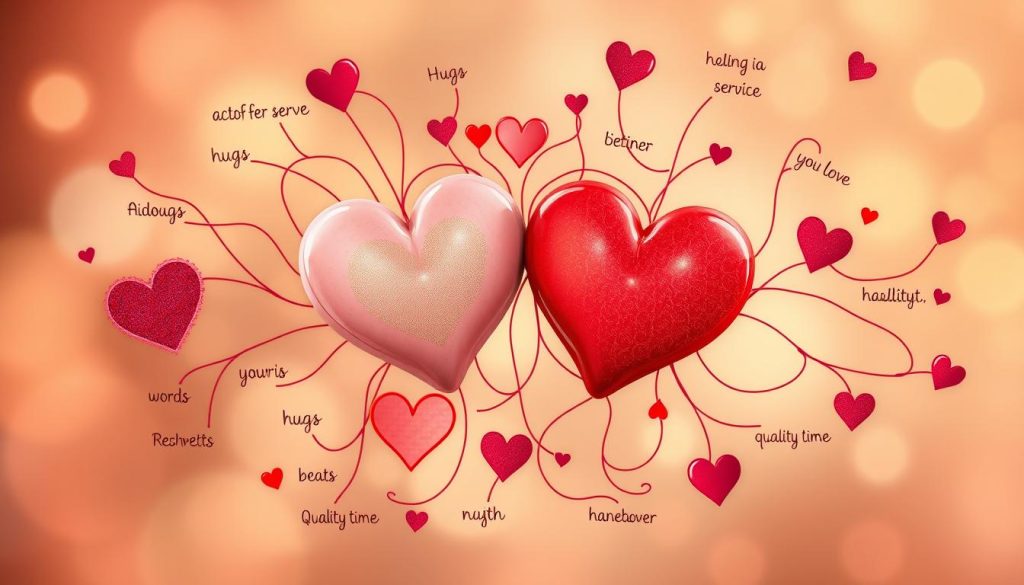In 1992, Dr. Gary Chapman changed how we see relationships with his book on love languages. This concept helps us understand how people express and receive love. Chapman shows us there are five main ways people feel loved: words of affirmation, quality time, acts of service, physical touch, and receiving gifts.
By knowing these love languages, we can deepen our connections with others. This understanding helps in all relationships, not just romantic ones. It’s about knowing what makes us and those we care about feel valued.
Love languages aren’t just for couples. They’re important for friends, family, and coworkers too. When we know our own love language and those of people around us, we can build better relationships. This leads to more empathy and a happier, more loving environment for everyone.
Key Takeaways
- Identifying personal and partner’s love languages can significantly improve relationship satisfaction.
- Love languages have unique expressions and gestures that communicate affection more effectively.
- Discovering and utilizing one’s primary love language supports personal growth and deepens connections.
- Physical touch and acts of service transcend verbal communication to convey love and care.
- Understanding connections through love languages enhances emotional intimacy in all types of relationships.
- Love languages influence how people prefer to give and receive love, shaping their emotional landscape.
The Concept of Love Languages
Exploring Gary Chapman’s love language theory opens up a world of communication styles in relationships. It was first thought of in the early 90s. Since then, it has deeply changed the way we understand and improve our relationships.
Origin and History
Gary Chapman, a counselor, noticed patterns in how couples show love. He wrote “The 5 Love Languages” in 1992. This book started a big change in expressing love effectively.
The Five Love Languages Explained
Gary Chapman talked about five ways people show and receive love: Words of Affirmation, Acts of Service, Receiving Gifts, Quality Time, and Physical Touch. Each one has its own way of strengthening love. Let’s look at what they mean:
- Words of Affirmation: Showing love by saying kind words, praise, or thanks.
- Acts of Service: Doing helpful things for the other person.
- Receiving Gifts: Giving things to show care and love.
- Quality Time: Spending focused time with your partner to build a deeper connection.
- Physical Touch: Showing love through hugs, kisses, and other touches.
Knowing and using these love languages can make partners feel more loved and understood.
Why They Matter
Using Gary Chapman’s love language theory helps partners empathize and understand each other better. A study in 2016 found that good communication leads to more intimacy. By showing and asking for love in ways that match you and your partner’s main love languages, you make the relationship stronger and happier.
| Love Language | Description | Effects on Relationships |
|---|---|---|
| Words of Affirmation | Showing love with kind words, praise, or thanks. | Makes verbal intimacy and respect grow. |
| Acts of Service | Doing helpful things for your partner. | Makes both feel more secure and cared for. |
| Receiving Gifts | Giving items to show love and thought. | Makes the bond stronger by showing you care. |
| Quality Time | Spending meaningful time together. | Deepens emotional connection and trust. |
| Physical Touch | Showing love through physical contact. | Makes love and attachment grow. |
Types of Love Languages
Love languages show how we show and feel love. They meet different emotional needs. Knowing about them can help us get along better. We’ll look at four main types, each special in how they show and receive love.
Words of Affirmation
The words of affirmation love language is all about talking. People like this need to hear “I love you,” compliments, and support out loud. When they hear how much they mean to someone, it makes them feel secure and loved.
Acts of Service
For some, love is all about doing things for each other. The acts of service love language means just that. Doing chores or errands shows them their partner cares. It’s a way of saying “I love you” without words.
Receiving Gifts
When gifts are someone’s love language, it’s the thought that counts. The receiving gifts love language cherishes the meaning behind every gift. Gifts make them feel valued not because of the item, but the care taken in choosing it.
Quality Time
For those who value the quality time love language, attention is everything. It means being fully there, without any distractions. They love doing things together and having meaningful talks.
| Love Language | Key Expression | Associated Actions |
|---|---|---|
| Words of Affirmation | Verbal expressions of love | Compliments, affirmations, appreciative remarks |
| Acts of Service | Action-oriented service | Doing chores, helping out, easing burdens |
| Receiving Gifts | Symbolic gifting | Thoughtful presents, surprise offerings |
| Quality Time | Focused attention | Active listening, shared activities, meaningful interactions |
By understanding the words of affirmation love language, acts of service love language, receiving gifts love language, and quality time love language, we can really make our loved ones feel special. It’s all about knowing what they like and showing them love in that way. This can make our relationships deeper and happier.
Importance of Identifying Your Love Language
Understanding your love language is key to deepening your connections. It’s crucial for understanding how love works. By knowing how you give and receive love, you can talk better. This helps you understand others more.
Enhancing Relationships
Knowing your and your partner’s love language helps match expressions of love. This leads to stronger feelings of love and appreciation. It goes beyond words, making actions more meaningful.
Building Better Communication
Knowing love languages makes communication clearer. If your partner prefers Quality Time, you can focus on that. This way, misunderstandings decrease and talks become healthier.
Addressing Misunderstandings
Many misunderstandings come from not knowing each other’s needs. Love languages clear this up. This understanding makes both feel valued, solving conflicts fast.

| Love Language | How to Express | Impact on Relationship |
|---|---|---|
| Words of Affirmation | Regularly vocalize appreciation and affection. | Increases verbal intimacy and reassurance. |
| Quality Time | Prioritize undistracted, one-on-one time. | Builds deeper emotional connections. |
| Receiving Gifts | Give thoughtful, personalized tokens of love. | Shows thoughtfulness and appreciation. |
| Acts of Service | Perform helpful tasks without being asked. | Reinforces reliability and teamwork in the relationship. |
| Physical Touch | Maintain a warm physical presence with affectionate gestures. | Enhances feelings of security and closeness. |
Understanding love languages can strengthen and enrich relationships. It shows the deep importance of this knowledge in our daily lives.
How to Discover Your Love Language
To find out how you express love, start by knowing your love language. Gary Chapman introduced a theory that helps improve relationships. Are you wondering about your own love language? Discover it by looking inward, listening to others, and possibly taking quizzes.
Self-Reflection Techniques
Think about when you felt really valued and loved. What actions or words made that moment special for you? It could have been a kind note, a thoughtful gift, or quality time with someone. These moments help figure out your main love language.
Asking for Feedback
Talk openly with your close ones to learn how you like to be loved. They can share times when you really appreciated their love gestures. This helps identify your love language.
Taking Love Language Quizzes
Quizzes are a structured way to understand your emotional needs. By answering questions about different situations, you can find out your most significant love language.
Knowing and sharing love in your unique way can make your relationships deeper and more rewarding. It’s about whether you need words of affirmation, quality time, gifts, help, or touch. Discovering your love language is worthwhile.
| Love Language | Preference | Impact |
|---|---|---|
| Words of Affirmation | 48% | Feeling valued through verbal acknowledgments |
| Acts of Service | 34% | Appreciation shown through helpful actions |
| Quality Time | 73% | Valuing undivided attention and shared activities |
| Physical Touch | 29% | Feeling loved through physical closeness |
| Receiving Gifts | 22% | Appreciating tangible expressions of love |
Love Languages in Romantic Relationships
Understanding love languages is key in relationships. It helps improve how we communicate and show our love. By knowing and respecting these languages, couples can overcome differences and build stronger bonds.
Balancing Different Love Languages
It’s important to recognize how each person shows and likes to receive love. If this is overlooked, it might cause misunderstandings. Learning and using your partner’s love language can greatly boost the happiness in your relationship.
Navigating Differences
Differences in love languages can lead to growth. For example, if one enjoys Quality Time and the other values Acts of Service, respecting these can make the relationship stronger. It brings partners closer, making the bond more satisfying.
Strengthening Bonds
Knowing your partner’s love language does wonders. It helps express love the right way and tightens the connection. This understanding meets emotional needs, making the relationship more intimate and strong.
| Love Language | Description | Benefits in Relationships |
|---|---|---|
| Words of Affirmation | Verbal expressions of love and appreciation. | Builds confidence and reinforces a positive relationship dynamic. |
| Quality Time | Undivided attention and shared activities. | Enhances feelings of togetherness and emotional connectivity. |
| Physical Touch | Non-verbal communication through physical contact. | Increases feelings of security and affection. |
| Acts of Service | Actions performed to ease your partner’s burdens. | Shows thoughtfulness and commitment. |
| Receiving Gifts | Giving of thoughtful and meaningful tokens. | Demonstrates mindfulness and cherishes the relationship. |
Love Languages Among Friends and Family
Gary Chapman’s love language theory is not just for couples. It’s powerful among friends and family too. Understanding it can deepen bonds in these relationships. It helps us get how we connect with those closest to us.
Non-Romantic Expressions of Love
Each love language has a special way to show care among friends and family. For families, acts of service might mean cooking or fixing things. Friends might show it by helping with projects or giving support when times are tough.
With words of affirmation, encouragement can strengthen emotional bonds. It creates a positive space for everyone. This shows how powerful words can be in our relationships.
Love Languages in Parenting
Using love languages in parenting creates a nurturing atmosphere at home. It’s great for a child’s emotional well-being. For example, spending quality time can mean playing games that interest the child. This shows the child they are valued.
Such moments are key in building trust. They help parents and children understand each other better.
Maintaining Close Friendships
For friendships to grow, mutual understanding and respect are essential. Recognizing each other’s love languages plays a big part in this.

Quality time or thoughtful gifts can strengthen friendship bonds. Understanding and using love languages improves connections.
| Love Language | Application in Friendship | Application in Family |
|---|---|---|
| Words of Affirmation | Compliments, supportive words | Encouragement, appreciative comments |
| Quality Time | Undivided attention, shared activities | Family game nights, one-on-one outings |
| Receiving Gifts | Thoughtful presents, remembering important dates | Celebratory gifts, gifts without occasion |
| Acts of Service | Helping in personal projects, support during tough times | Household chores, caring gestures |
| Physical Touch | Affectionate gestures appropriate to the relationship | Hugs, comforting touches |
Using love languages well can enrich our relationships. Trust Mental Health says it boosts bonds in families and friendships. It’s about understanding and respecting what matters to each other. This builds a foundation of mutual respect and deep connections.
Common Misconceptions about Love Languages
Understanding Gary Chapman’s love language theory means clearing up common myths. These myths can stop us from showing love well in relationships. It’s vital to tackle these wrong ideas to improve relationships and encourage growth.
Love Languages Are Static
Some think once a love language is identified, it stays the same. However, this isn’t true. Love languages can change as people grow and their situations change. Knowing this helps us keep showing love right as relationships evolve.
Everyone Has the Same Love Language
The idea that we all have the same love language is incorrect. Each of us has a unique way we feel loved, affected by our experiences, culture, and choices. Understanding and valuing these differences is key to strong relationships.
Love Languages Only Apply to Romance
Many believe love languages are just for romantic relationships. This isn’t correct. Love languages are also important in friendships, families, and even at work.
| Misconception | Reality | Impact |
|---|---|---|
| Love languages are unchanging | Dynamic throughout life | Requires flexibility and adaptation in relationships |
| All individuals share identical love languages | Varies from one individual to another | Calls for personalized approaches in expressing affection |
| Applicable only in romantic scenarios | Relevant in various types of relationships | Enhances broader interpersonal connections |
To really understand Gary Chapman’s love language theory and express love effectively, we need to look past these myths. We should adopt a flexible, understanding attitude towards relationships. This way, we forge deeper, more caring connections with others, no matter the type of relationship.
The Role of Love Languages in Personal Growth
Learning about your love languages is key to growing as a person. It helps you connect deeply with others and improves your self-understanding and empathy. Gary Chapman’s love language theory gives us a clear way to see how different people show and need love in various ways.
Understanding Your Needs
Knowing your main love language—whether it’s words of affirmation, quality time, physical touch, acts of service, or receiving gifts—helps you understand what you need emotionally. This insight is vital for loving yourself properly. It helps you look for and stand up for what makes you feel loved and appreciated.
Developing Empathy
When you get how love languages work for others, you naturally become more empathetic. Realizing we all have unique emotional needs helps you be more considerate. Empathy comes as you respect and acknowledge these differences, leading to stronger connections.
Improving Self-Awareness
Exploring Gary Chapman’s love language theory boosts self-awareness too. Figuring out your love style shows your habits and points out ways to get better in relationships. This self-reflection encourages you to love yourself actively and consider how you impact those close to you.
Looking at personal growth through love languages links self-improvement with better relationships. Understanding your love languages means growing in self-love and building empathy with others. This approach makes every relationship richer and more meaningful.
Resources for Exploring Love Languages
Understanding Gary Chapman’s love language theory can change your relationships and how you see yourself. There are many resources out there for those who want to get better at showing love. These resources help people improve their relations and understand love languages better, like the book “The 5 Love Languages.”
Books to Read
Dr. Gary Chapman’s book “The 5 Love Languages” is key for learning about love languages. It explains the five main love languages and gives tips and ideas to make relationships stronger. This book helps you know what you and your loved ones need, leading to happier and more connected relationships.
Online Courses and Workshops
Online courses and workshops are great for digging deeper into love languages. They provide tools for using them in real life. You can learn from experts, join interactive exercises, and talk with others. This helps improve how you communicate, understand others, and express love, building stronger bonds.
Support Groups and Community Events
Support groups and community events are also very helpful. They’re good for people who like learning from others’ experiences. By taking part, you can share stories, discuss love language strategies, and get support from peers. These events give you new insights on how different people use love languages, making you feel connected with others exploring the same ideas.



